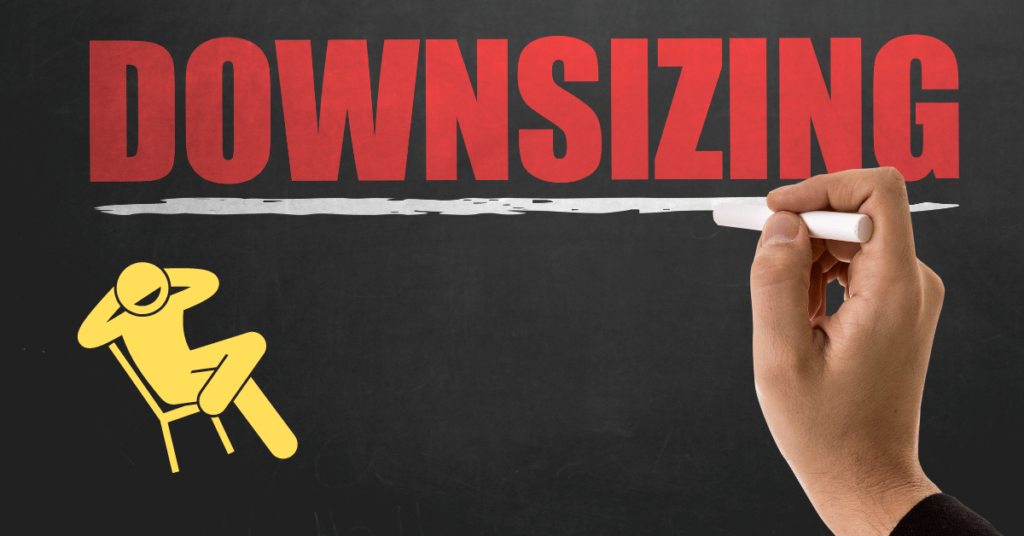Downsizing for retirement can be a practical and effective way to reduce expenses and simplify your lifestyle. Many retirees find that living in a smaller home or less expensive area frees up resources for travel, hobbies, or just more peace of mind.
This guide will walk you through the key steps involved in downsizing for retirement, from evaluating your current situation to making the move.
Evaluate Your Current Needs
Before making any decisions, it’s essential to evaluate what you truly need in retirement. Ask yourself these questions:
- How much space do you realistically need?
- What items or belongings are essential, and what can you let go of?
- What are your lifestyle goals in retirement (e.g., travel, spending more time with family, or pursuing hobbies)?
Understanding your priorities will help you make informed choices about where and how to live.
Benefits of Downsizing

Financial Savings
The most obvious benefit of downsizing is the potential for financial savings. A smaller home typically means lower mortgage payments (or none at all), reduced property taxes, and lower utility and maintenance costs. These savings can significantly improve your financial stability in retirement.
Reduced Maintenance
A smaller home or a property in a retirement community often requires less upkeep. This allows you to spend less time on chores and more time enjoying retirement.
Simplified Living
Downsizing forces you to declutter and simplify your life. You’ll have fewer belongings to manage, and the reduction in “stuff” can be incredibly freeing, both physically and mentally.
Location Flexibility
Downsizing may also open up the possibility of moving to a new location. Whether it’s to be closer to family, live in a more affordable area, or settle in a place with better weather, downsizing provides more options.
When to Consider Downsizing
Financial Constraints
If you find yourself struggling to keep up with housing expenses or if your retirement savings are limited, downsizing may be a necessary step. Freeing up equity from your current home can provide you with additional retirement funds.
Mobility or Health Issues
As you age, maintaining a large home may become physically challenging. Moving to a single-story house or a smaller space with fewer stairs and maintenance requirements can be a wise choice, especially if you face health or mobility concerns.
Life Transition
If your children have moved out or you’re facing the loss of a spouse, it might be time to downsize. A smaller space can help you adjust to these changes and feel more comfortable in your new phase of life.
How to Begin the Downsizing Process

1. Declutter Your Home
The first step in downsizing is decluttering. Go room by room and categorize your belongings into three categories: keep, donate, or discard. Sentimental items may be the hardest to let go of, but consider keeping just a few meaningful pieces and digitizing the rest (e.g., photos).
2. Determine Your New Home’s Size
Decide how much space you’ll need in your new home. This could be a smaller single-family house, a condo, or an apartment. Make sure to factor in your lifestyle needs, including space for guests, hobbies, or storage.
3. Research Locations
Where you choose to downsize can significantly impact your retirement experience. Consider factors such as:
- Cost of living
- Proximity to family and friends
- Access to healthcare
- Weather and climate preferences
- Tax implications (e.g., states with no income tax or lower property taxes)
4. Selling or Renting Your Current Home
If you own your home, selling it can provide you with significant equity that can be reinvested into your new, smaller home, or used to bolster your retirement savings. Alternatively, renting out your home can generate income while still allowing you to keep the property as an asset.
5. Make the Move
Once you’ve decluttered, found a new home, and sold or rented your old one, it’s time to move. Hire professional movers if possible to reduce stress, and give yourself plenty of time to settle into your new space.
Downsizing Alternatives
1. Aging in Place
If you love your current home and don’t want to move, you might consider “aging in place.” This means modifying your home to suit your needs as you age, such as installing grab bars in the bathroom, creating a first-floor bedroom, or reducing the need for stairs.
2. Renting Instead of Buying
Some retirees choose to rent instead of purchasing a new home. Renting can provide flexibility, especially if you’re not ready to commit to one location. It can also reduce maintenance responsibilities and allow you to “test out” living in different areas.
3. Moving to a Retirement Community
Retirement communities are specifically designed for older adults and can offer a range of benefits such as social activities, healthcare facilities, and reduced maintenance responsibilities. This can be a good option if you value a built-in community and services.
FAQs
What’s the best time to downsize for retirement?
There’s no perfect time to downsize, but many retirees choose to do it in their 60s or early 70s, when they are still active enough to manage a move and before significant health issues arise. Downsizing earlier can also help free up money for travel or other retirement activities.
Should I rent or buy when I downsize?
Both options have their pros and cons. Renting offers more flexibility, especially if you’re not sure where you want to settle long-term. Buying can provide more stability and allow you to build equity. Your decision should depend on your financial goals and personal preferences.
What should I do with sentimental items when downsizing?
It’s natural to struggle with letting go of sentimental items. Consider keeping only a few important pieces and digitizing photos or mementos to save space. You might also pass down items to family members as a way to preserve their memory.
How much money can I save by downsizing?
The savings from downsizing depend on factors such as the size of your current home, property taxes, and the cost of your new home. However, it’s common for retirees to save thousands of dollars annually through reduced mortgage payments, utilities, taxes, and maintenance costs.
Conclusion
Downsizing for retirement can be a smart way to free up financial resources and simplify your life. By carefully evaluating your needs, decluttering, and considering your housing options, you can make the transition smoother and set yourself up for a more comfortable and enjoyable retirement. Whether you choose to move into a smaller home, rent, or even join a retirement community, downsizing offers the opportunity for a fresh start in your golden years.
If you have any further questions feel free to comment down below or contact retiresmart for any help!




